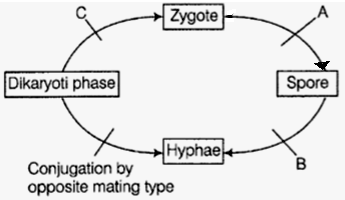By all of the following ways bacteria become resistant to antibiotic except
(1) making enzymes that inactivate the drug
(2) becoming impermeable to the drug
(3) modifying the target of the drug
(4) moving away from the drug.
Protista differs from monera in having
1. cell wall
2. autotrophic nutrition
3. flagella
4. nuclear membrane
Which of the following is correct?
1. All fungi are filamentous.
2. Transfer of DNA from one bacteria to another bacteria cannot take place.
3. Virus cannot have both DNA and RNA.
4. Protists reproduce asexually only.
The genetic material in tobacco mosaic virus is
(1) ss DNA
(2) ss RNA
(3) ds RNA
(4) ds DNA
Yeast is not included in protozoans but in fungi because
(1) it has chlorophyll
(2) it shows saprotrophic mode of nutrition
(3) it has eukaryotic organisation
(4) cell wall is made up of cellulose and reserve food material as starch.
Identify the labelled part in the given figure and select the correct option.
| A | B | |
| 1. | Heterocyst | Mucilaginous sheath |
| 2. | Mucilaginous sheath | Heterocyst |
| 3. | Heterocyst | Capsid |
| 4. | Pseudopodia | Mucilaginous sheath |
Read the following statement regarding bacteria.
I. Bacteria exchnage their genetic matter through conjugation which involve cell to cell contact.
II. Transduction in 'Salmonella is reported by Tatum and Lederberg in 1952.
III. Citrus canker disease is caused by bacteria Xanthomonas citri.
IV. Hans Christian gram's staining method is based on cell wall composition of bacteria.
Choose the correct option with true statements.
(1) I and III
(2) I, III and IV
(3) I, II, and III
(4) II and IV
Heterocysts present in Nostoc is specialised for
(1) fragmentation
(2) nitrogen-fixation
(3) symbiotic relation
(4) food storage
Refer to the following figures.
Match the following columns and choose the correct option from the codes given below.
|
C-I |
Column I |
Column II |
|
A |
I. Euglena |
I. kinetoplast |
|
B |
II. Paramecium |
II. Trichocysts |
|
C |
III. Trypanosoma |
III. Astaxanthin |
Codes:
|
|
A |
B |
C |
|
(1) |
3-II |
1-III |
2-I |
|
(2) |
1-II |
3-I |
2-I |
|
(3) |
1-III |
2-II |
3-I |
|
(4) |
3-I |
2-II |
1-III |
The given below figure shows a generalised life cycle of a fungus. Identify A, B and C from the given option.

| A | B | C |
(1) | Meiosis | Fertilisation | Meiosis |
(2) | Meiosis | Mitosis | Fertilisation |
(3) | Mitosis | Meiosis | Fertilisation |
(4) | Mitosis | Fertilisation | Meiosis |








